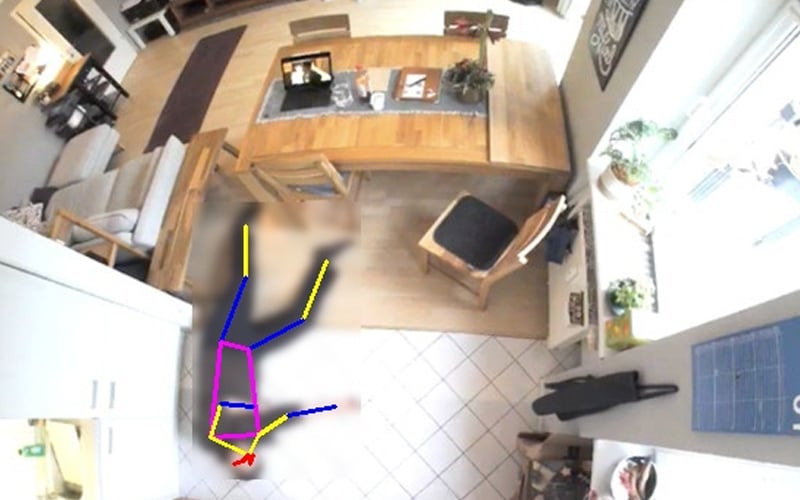Fall detection in nursing homes: Camera vs. radar
.png)
But how do they actually work in detail and what is the difference between camera-based fall detection and radar?
And why do we specifically rely on the combination of video camera and radar in the Livy sensor station? We would like to explain these questions in further detail in our article.
As the staffing situation in nursing homes and senior residences becomes increasingly tense, monitoring systems for fall analysis, fall prevention and fall detection can become an efficient tool. Which system should you go for?
Fall detection with radar
Radio detection and ranging - or radar for short - is an active transmission and reception method in the microwave GHz range. The radar sensor technology enables detection, i.e. recording, tracking and localization of one or more objects. The radar waves transmitted by the radar antenna travel at the speed of light. When these waves hit objects, the signal changes and is reflected back to the radar sensor. The received waves contain information about the object. This information is evaluated to identify and locate the object. This "non-visual" detection provides precise data on the speed, position and direction of movement of an object. Consequently, it can also be used to identify whether a person is falling.
The advantages of fall detection with radar
- Independent of lighting conditions
Radar systems are independent of lighting conditions and therefore also work at night in darkness or in dim light from, for example, bedside lamps. - Large range of detection
Radar systems basically have a relatively large range compared to cameras and can cover a larger area depending on the installation location. - Data protection and privacy are preserved
Thanks to non-visual detection, the use of radar systems is non-invasive and preserves both the privacy and data protection of staff and patients.
The disadvantages of fall detection with radar
-
Sensitivity to interference:
Radar systems can be interfered with by other electronic devices, such as microwaves or WLAN signals, which can result in false alarms or lack of detection. -
Limitations in terms of surveillance:
Radar systems are not able to see through other obstacles, making it difficult to detect movement behind larger objects such as furnitures.
Also, radar is dependent on the dimensions detected and thus cannot always be mounted centrally on the ceiling, for example. This restricts the detection range thanks to pieces of furniture, doors, etc. This is a major disadvantage compared to camera systems. -
Higher cost:
Radar systems are typically more expensive than camera systems, which can make them more difficult for some facilities to implement. -
Difficulty in integrating with existing systems:
Integrating radar systems into existing surveillance systems can be difficult because they require specialized technology. -
The accuracy of detected movements
In some cases, it can be difficult to detect slow falls with a radar system because it may not be sensitive enough to them. In addition, it can be difficult to distinguish between a fall and other movements, which can also lead to false alarms. -
Inability of detailed monitoring
Because radar systems do not provide visual monitoring, it can be difficult to accurately assess the cause of a fall or the injuries that result.
It is important to note that each system has its own advantages and disadvantages and that it is important to consider the specific requirements of a facility and the needs of its residents when selecting a system.
Fall detection with camera
Camera-based fall detection systems use computer image processing and AI technologies to detect and analyze motion in a monitored area. The camera captures images or video clips of the monitored area and the system's image processing software analyzes the movements of people and objects in the monitored area. Camera-based fall detection systems typically have higher accuracy than radar-based systems.
The advantages of fall detection with camera
- Precise detection:
A camera can detect a person's movements more precisely than other technologies such as accelerometers. If it is placed centrally on the ceiling, the camera can also detect people behind objects. - Additional information:
A camera can also provide additional information such as the environment and context of a person, which can be useful for a better assessment of the situation.
For example, it can define the position a person is in. (lying, sitting or standing). - Prevention of false alarms:
By using a camera, you can ensure that an alarm is only triggered when a fall has actually occurred, and not by other factors such as a sudden fall or similar. The detection here works much more precisely than a radar and evaluates more data to give a reliable detection. - Monitoring option:
Fall detection with camera can also be used to provide real-time monitoring, which can be beneficial for elderly or sick people. - Multimedia data capture:
A camera also makes it possible to capture multimedia data such as images or videos.
Depending on the area of application, the process etc. can be better evaluated and documented in the post-processing of a fall.
The disadvantages of fall detection with camera
- Depending on lighting conditions
In poor lighting conditions or in the dark, the image data cannot be captured and evaluated correctly. - Data privacy issues
The use of cameras can pose data protection problems, as personal data is involved if the image data of the individuals is not abstracted.
Which technology is better depends on the specific requirements and goals of the application. For accurate monitoring of movements and postures, camera-based fall detection is more suitable, while for monitoring in low-light conditions or obstacles, radar-based fall detection may be more appropriate. Combining the two, the advantages of each system can be used to compensate for the disadvantages of one with the other.
Why do we combine camera and radar for our Livy fall detection?
The combination of camera and radar-based fall detection can provide a variety of benefits, especially in the context of elderly care:
-
Increased accuracy:
By combining the two systems, it is possible to achieve higher fall detection accuracy, as each system has its own strengths and weaknesses, allowing potential errors of one system to be compensated by the other. -
Avoiding false alarms:
The combination of camera and radar-based fall detection can help avoid false alarms, as both systems must be linked and confirm each other before an alarm is triggered. -
Monitoring in different environments:
By combining the two systems, it is possible to provide monitoring in good lighting conditions as well as in low light and in the presence of obstacles, which can be an advantage when caring for the elderly. For example, the Livy sensor station can be mounted on the ceiling and allows an unrestricted field of view of people - during the day and at night. -
Maximum accuracy with data protection in mind
While data protection and privacy are already preserved with radar, this is usually a problem with cameras. With Livy, the image data of the persons is therefore additionally abstracted and does not allow any conclusions to be drawn about the person themselves.
In this way, we achieve maximum accuracy of fall detection in combination with both systems, while at the same time taking data protection and privacy into account.
Overall, the combination of camera and radar-based fall detection provides a more comprehensive monitoring solution that offers higher accuracy and false alarm prevention, and enables fall detection in different environments and lighting conditions.
We want to provide you with the highest level of safety and efficient fall detection for your fall prevention.
Therefore, we rely on the combination of both systems to achieve maximum results. Do you have any further questions? Our experts will be happy to answer your questions in a non-binding consultation.
